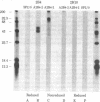Abstract
A pigeon cytochrome c-specific and Ia molecule-restricted T-cell hybrid was used as an immunogen in order to obtain monoclonal anti-antigen receptor antibodies. Two antibodies were isolated that specifically bound to and inhibited interleukin (IL) 2 release from only the immunizing clone. Lectin-induced IL 2 release was not affected by these antibodies. Binding assays with purified and iodinated monoclonal antibody indicated that there were approximately equal to 25,000 binding sites on the T-cell hybrid. Immunoprecipitation and NaDodSO4/polyacrylamide gel electrophoresis of detergent lysates from surface-labeled hybrid cells revealed a heterodimeric structure composed of chains of apparent Mrs 45,000-50,000 and 40,000-44,000. The chains were linked by intermolecular disulfide bonds, and the difference in migration of the isolated chains under reducing and nonreducing conditions was consistent with the presence of intramolecular disulfide bonds. The molecule that has been identified is a candidate for the antigen-specific receptor on the immunizing T-cell clone.
Full text
PDF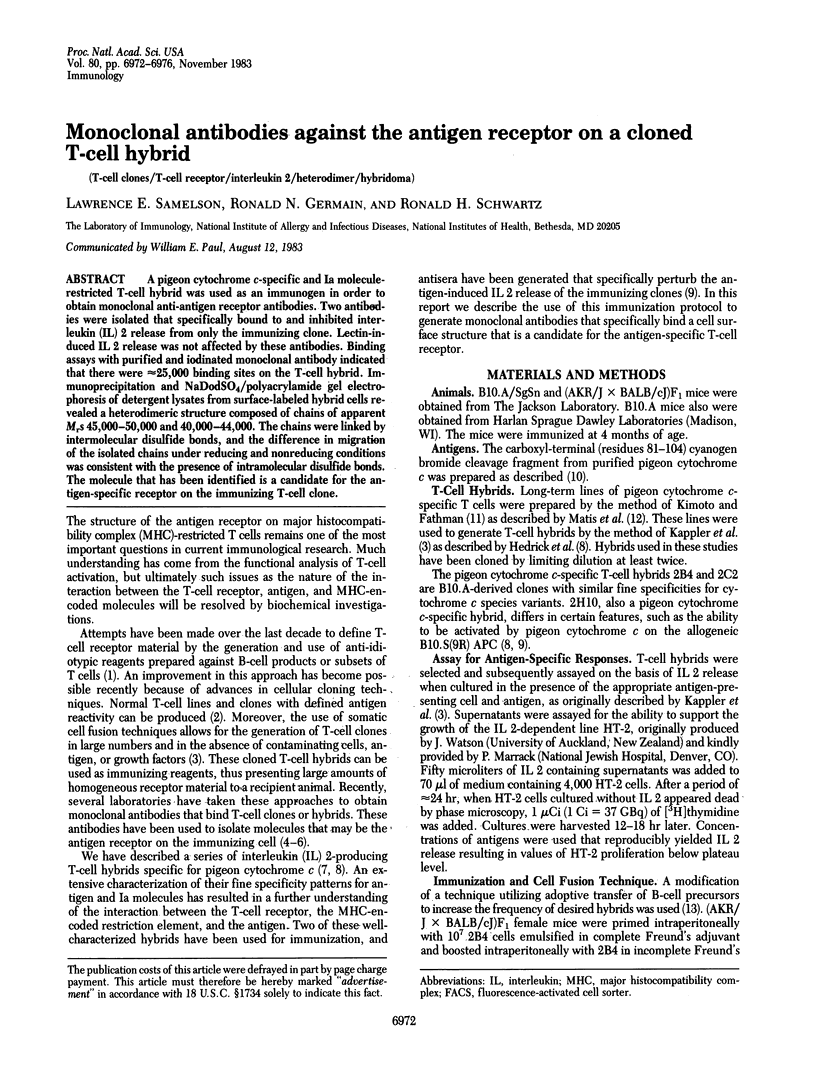
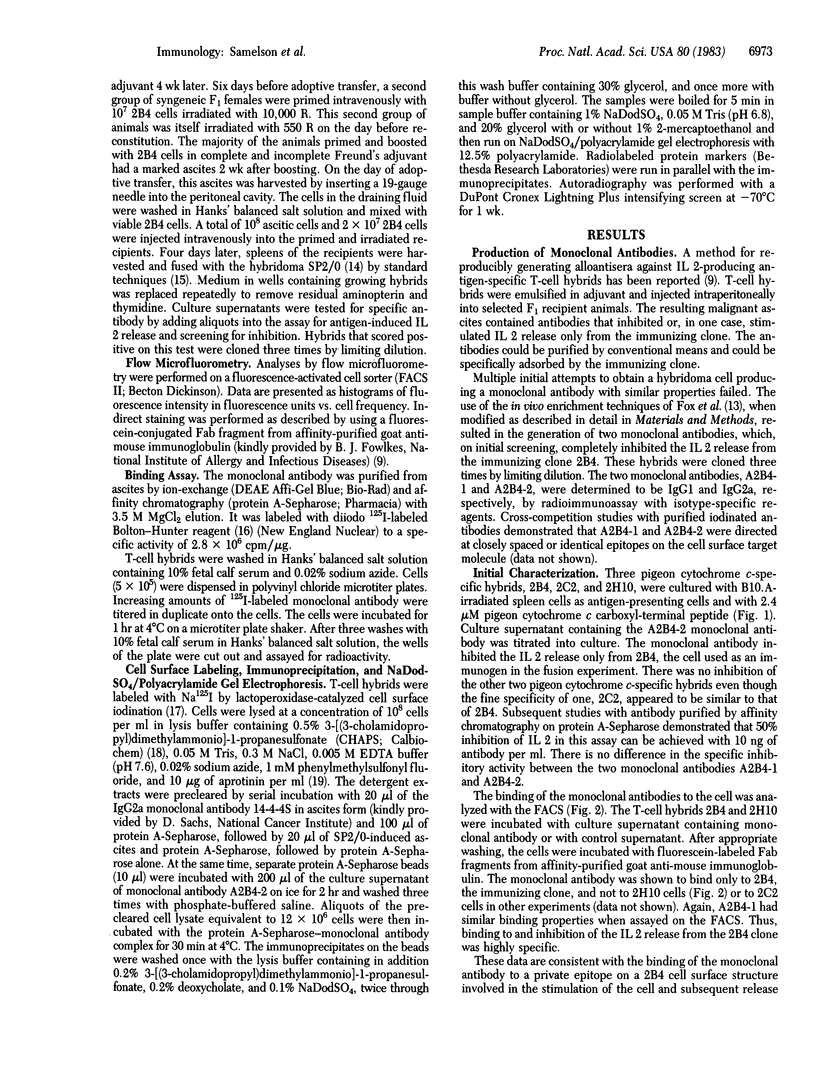
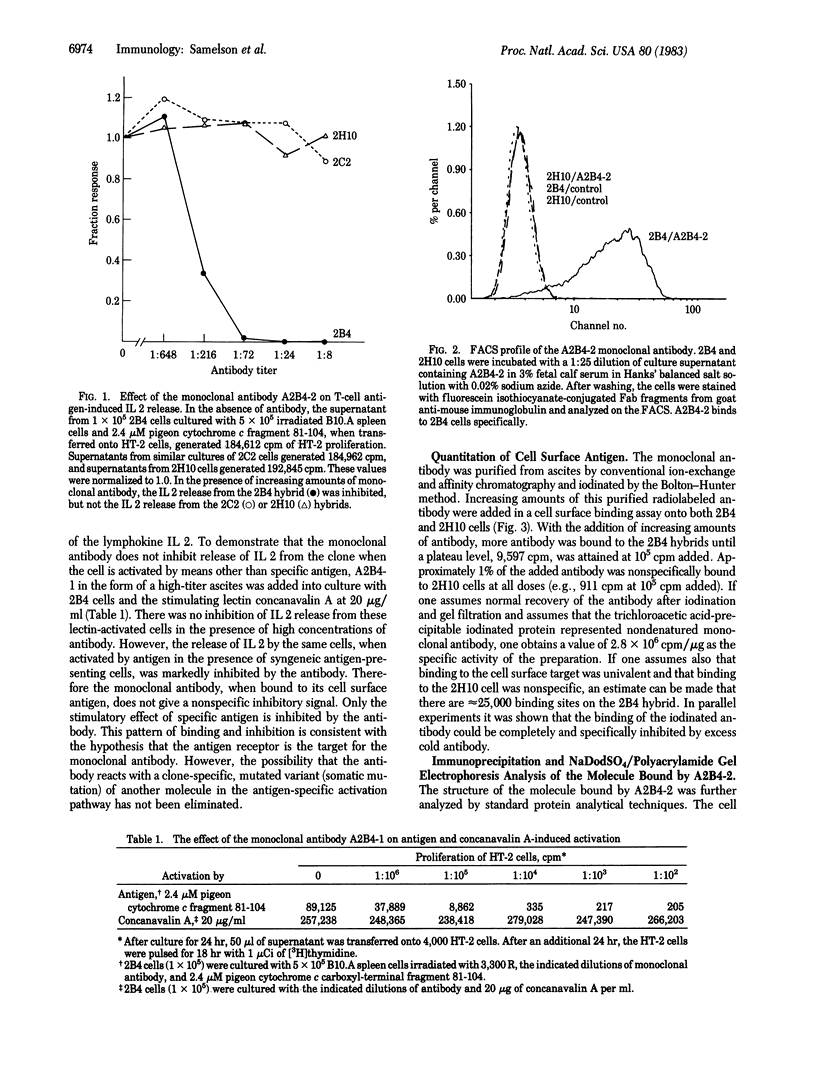
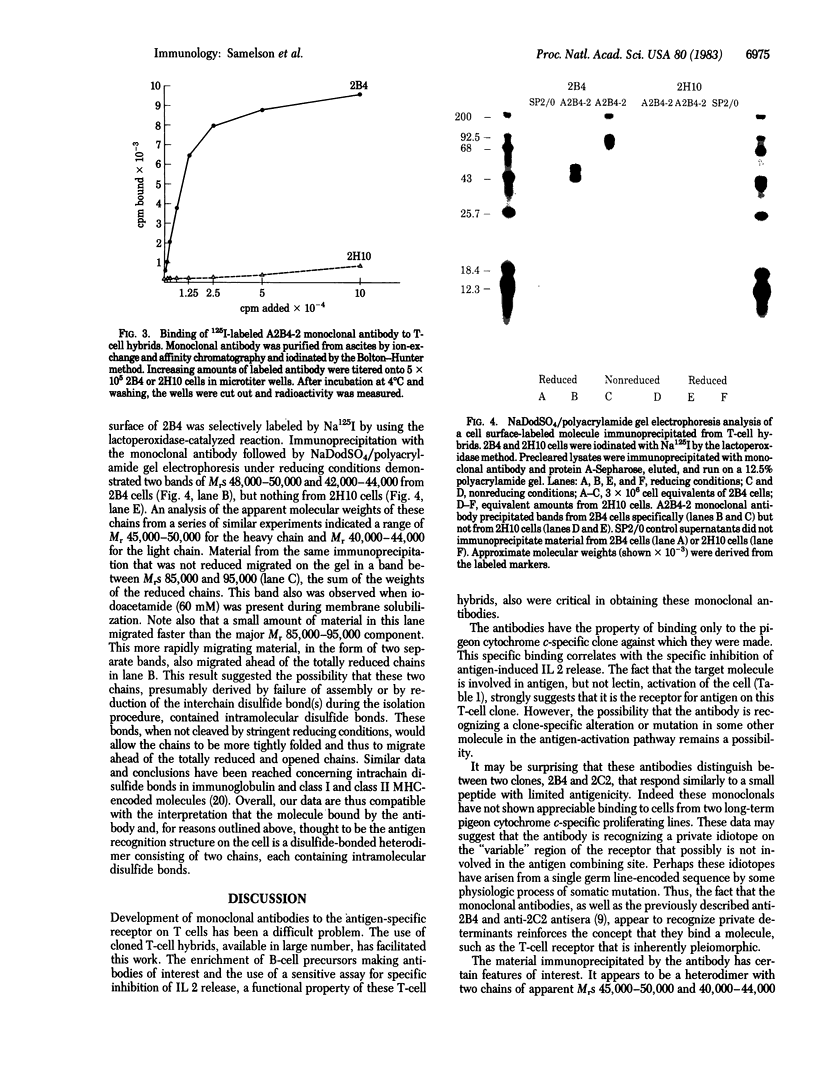
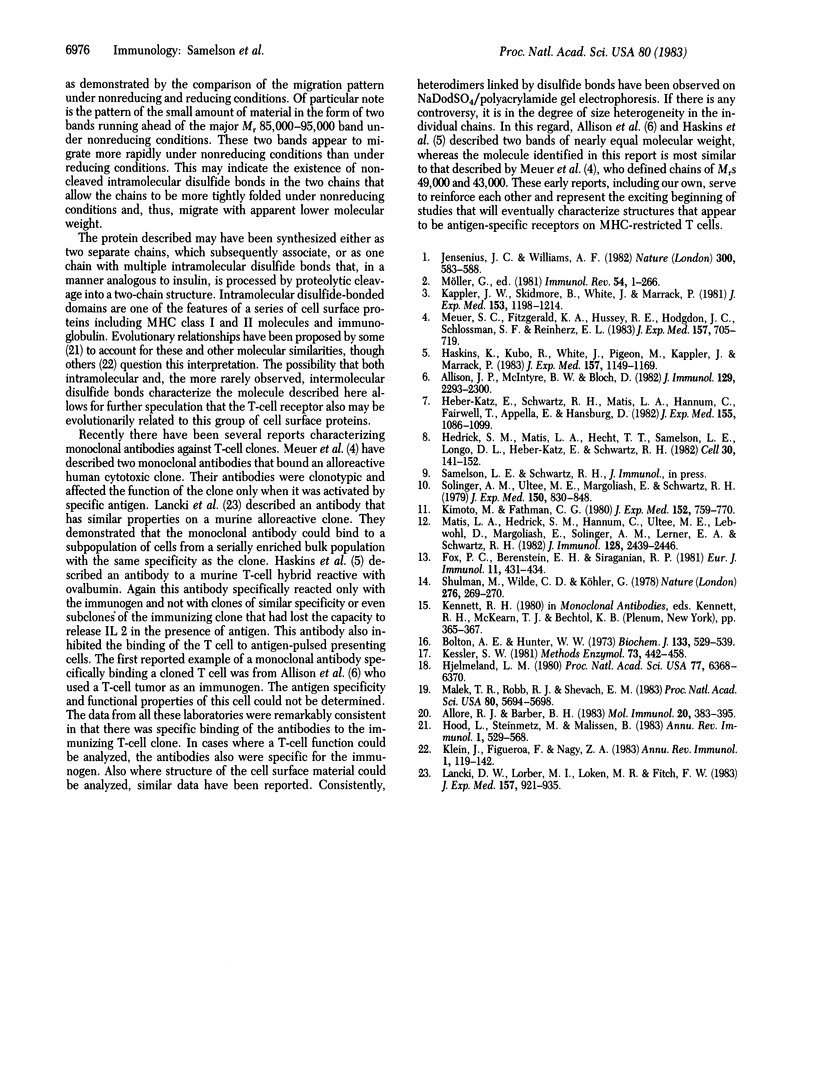
Images in this article
Selected References
These references are in PubMed. This may not be the complete list of references from this article.
- Allison J. P., McIntyre B. W., Bloch D. Tumor-specific antigen of murine T-lymphoma defined with monoclonal antibody. J Immunol. 1982 Nov;129(5):2293–2300. [PubMed] [Google Scholar]
- Allore R. J., Barber B. H. Inter- and intramolecular disulfide bonding among lymphocyte plasma membrane proteins and glycoproteins. Mol Immunol. 1983 Apr;20(4):383–395. doi: 10.1016/0161-5890(83)90020-2. [DOI] [PubMed] [Google Scholar]
- Bolton A. E., Hunter W. M. The labelling of proteins to high specific radioactivities by conjugation to a 125I-containing acylating agent. Biochem J. 1973 Jul;133(3):529–539. doi: 10.1042/bj1330529. [DOI] [PMC free article] [PubMed] [Google Scholar]
- Fox P. C., Berenstein E. H., Siraganian R. P. Enhancing the frequency of antigen-specific hybridomas. Eur J Immunol. 1981 May;11(5):431–434. doi: 10.1002/eji.1830110516. [DOI] [PubMed] [Google Scholar]
- Haskins K., Kubo R., White J., Pigeon M., Kappler J., Marrack P. The major histocompatibility complex-restricted antigen receptor on T cells. I. Isolation with a monoclonal antibody. J Exp Med. 1983 Apr 1;157(4):1149–1169. doi: 10.1084/jem.157.4.1149. [DOI] [PMC free article] [PubMed] [Google Scholar]
- Heber-Katz E., Schwartz R. H., Matis L. A., Hannum C., Fairwell T., Appella E., Hansburg D. Contribution of antigen-presenting cell major histocompatibility complex gene products to the specificity of antigen-induced T cell activation. J Exp Med. 1982 Apr 1;155(4):1086–1099. doi: 10.1084/jem.155.4.1086. [DOI] [PMC free article] [PubMed] [Google Scholar]
- Hedrick S. M., Matis L. A., Hecht T. T., Samelson L. E., Longo D. L., Heber-Katz E., Schwartz R. H. The fine specificity of antigen and Ia determinant recognition by T cell hybridoma clones specific for pigeon cytochrome c. Cell. 1982 Aug;30(1):141–152. doi: 10.1016/0092-8674(82)90020-4. [DOI] [PubMed] [Google Scholar]
- Hjelmeland L. M. A nondenaturing zwitterionic detergent for membrane biochemistry: design and synthesis. Proc Natl Acad Sci U S A. 1980 Nov;77(11):6368–6370. doi: 10.1073/pnas.77.11.6368. [DOI] [PMC free article] [PubMed] [Google Scholar]
- Hood L., Steinmetz M., Malissen B. Genes of the major histocompatibility complex of the mouse. Annu Rev Immunol. 1983;1:529–568. doi: 10.1146/annurev.iy.01.040183.002525. [DOI] [PubMed] [Google Scholar]
- Jensenius J. C., Williams A. F. The T lymphocyte antigen receptor--paradigm lost. Nature. 1982 Dec 16;300(5893):583–588. doi: 10.1038/300583a0. [DOI] [PubMed] [Google Scholar]
- Kappler J. W., Skidmore B., White J., Marrack P. Antigen-inducible, H-2-restricted, interleukin-2-producing T cell hybridomas. Lack of independent antigen and H-2 recognition. J Exp Med. 1981 May 1;153(5):1198–1214. doi: 10.1084/jem.153.5.1198. [DOI] [PMC free article] [PubMed] [Google Scholar]
- Kessler S. W. Use of protein A-bearing staphylococci for the immunoprecipitation and isolation of antigens from cells. Methods Enzymol. 1981;73(Pt B):442–459. doi: 10.1016/0076-6879(81)73084-2. [DOI] [PubMed] [Google Scholar]
- Kimoto M., Fathman C. G. Antigen-reactive T cell clones. I. Transcomplementing hybrid I-A-region gene products function effectively in antigen presentation. J Exp Med. 1980 Oct 1;152(4):759–770. doi: 10.1084/jem.152.4.759. [DOI] [PMC free article] [PubMed] [Google Scholar]
- Klein J., Figueroa F., Nagy Z. A. Genetics of the major histocompatibility complex: the final act. Annu Rev Immunol. 1983;1:119–142. doi: 10.1146/annurev.iy.01.040183.001003. [DOI] [PubMed] [Google Scholar]
- Lancki D. W., Lorber M. I., Loken M. R., Fitch F. W. A clone-specific monoclonal antibody that inhibits cytolysis of a cytolytic T cell clone. J Exp Med. 1983 Mar 1;157(3):921–935. doi: 10.1084/jem.157.3.921. [DOI] [PMC free article] [PubMed] [Google Scholar]
- Malek T. R., Robb R. J., Shevach E. M. Identification and initial characterization of a rat monoclonal antibody reactive with the murine interleukin 2 receptor-ligand complex. Proc Natl Acad Sci U S A. 1983 Sep;80(18):5694–5698. doi: 10.1073/pnas.80.18.5694. [DOI] [PMC free article] [PubMed] [Google Scholar]
- Matis L. A., Hedrick S. M., Hannum C., Ultee M. E., Lebwohl D., Margoliash E., Solinger A. M., Lerner E. A., Schwartz R. H. The T lymphocyte response to cytochrome C. III. Relationship of the fine specificity of antigen recognition to major histocompatibility complex genotype. J Immunol. 1982 Jun;128(6):2439–2446. [PubMed] [Google Scholar]
- Meuer S. C., Fitzgerald K. A., Hussey R. E., Hodgdon J. C., Schlossman S. F., Reinherz E. L. Clonotypic structures involved in antigen-specific human T cell function. Relationship to the T3 molecular complex. J Exp Med. 1983 Feb 1;157(2):705–719. doi: 10.1084/jem.157.2.705. [DOI] [PMC free article] [PubMed] [Google Scholar]
- Shulman M., Wilde C. D., Köhler G. A better cell line for making hybridomas secreting specific antibodies. Nature. 1978 Nov 16;276(5685):269–270. doi: 10.1038/276269a0. [DOI] [PubMed] [Google Scholar]
- Solinger A. M., Ultee M. E., Margoliash E., Schwartz R. H. T-lymphocyte response to cytochrome c. I. Demonstration of a T-cell heteroclitic proliferative response and identification of a topographic antigenic determinant on pigeon cytochrome c whose immune recognition requires two complementing major histocompatibility complex-linked immune response genes. J Exp Med. 1979 Oct 1;150(4):830–848. doi: 10.1084/jem.150.4.830. [DOI] [PMC free article] [PubMed] [Google Scholar]



